Managerial Finance Report: Funding, Investment, and Company Evaluation
VerifiedAdded on 2020/06/04
|16
|3806
|28
Report
AI Summary
This report provides a detailed analysis of managerial finance, encompassing various critical aspects. It begins by exploring different sources of funding, both internal and external, along with their respective advantages and disadvantages. The report then delves into investment proposal techniques, including their limitations, and provides a comprehensive overview of accounting rate of return, internal rate of return, and payback period. The importance and usage of management tools such as budgets and break-even analysis are thoroughly discussed, with calculations for break-even analysis and cash budgets over a three-month period. Furthermore, the report evaluates company performance, conducts a literature review of budgets and break-even analysis, and highlights their significance to an organization. Finally, it addresses key issues that management must consider for survival and profit generation, concluding with recommendations for effective financial management.

Managerial Finance
Paraphrase This Document
Need a fresh take? Get an instant paraphrase of this document with our AI Paraphraser
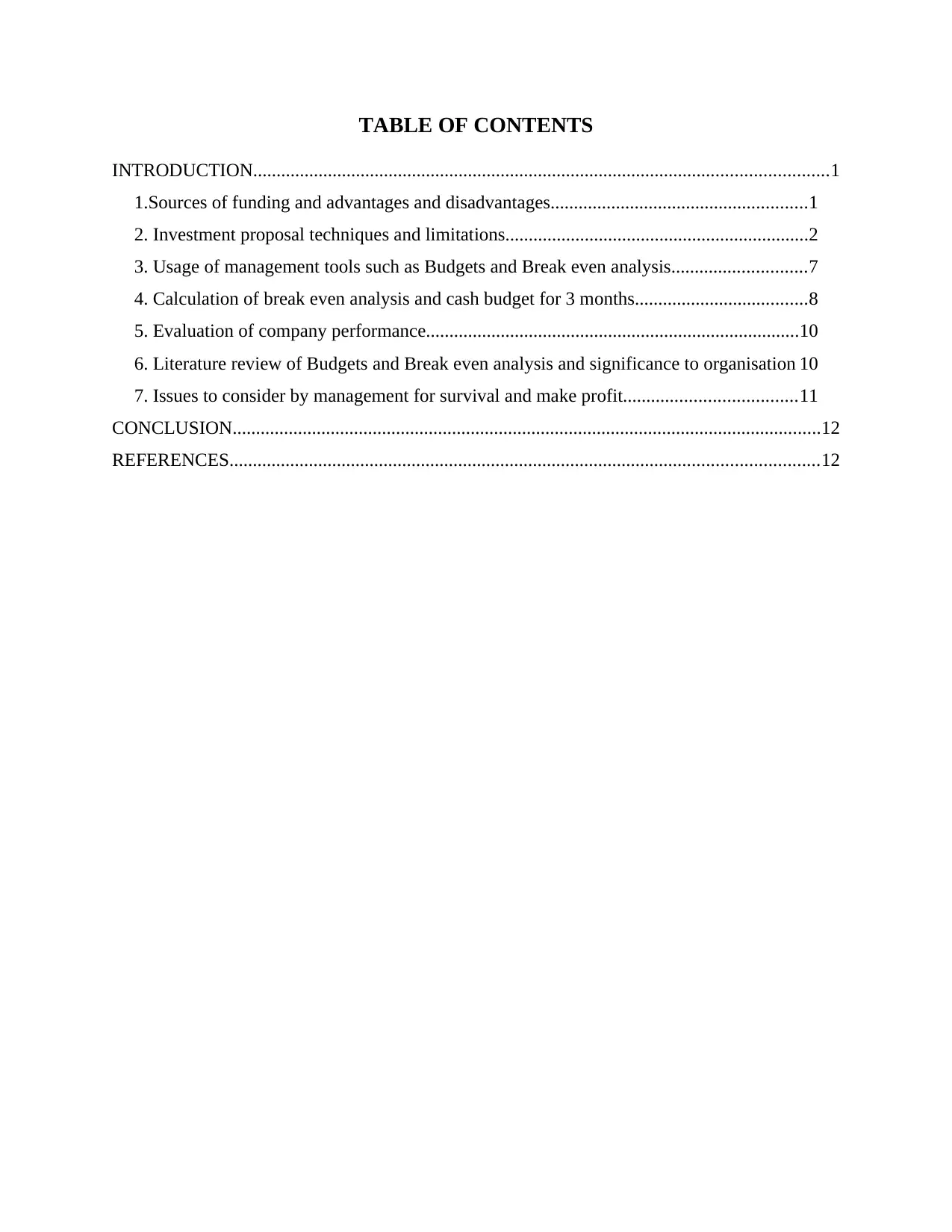
TABLE OF CONTENTS
INTRODUCTION...........................................................................................................................1
1.Sources of funding and advantages and disadvantages.......................................................1
2. Investment proposal techniques and limitations.................................................................2
3. Usage of management tools such as Budgets and Break even analysis.............................7
4. Calculation of break even analysis and cash budget for 3 months.....................................8
5. Evaluation of company performance................................................................................10
6. Literature review of Budgets and Break even analysis and significance to organisation 10
7. Issues to consider by management for survival and make profit.....................................11
CONCLUSION..............................................................................................................................12
REFERENCES..............................................................................................................................12
INTRODUCTION...........................................................................................................................1
1.Sources of funding and advantages and disadvantages.......................................................1
2. Investment proposal techniques and limitations.................................................................2
3. Usage of management tools such as Budgets and Break even analysis.............................7
4. Calculation of break even analysis and cash budget for 3 months.....................................8
5. Evaluation of company performance................................................................................10
6. Literature review of Budgets and Break even analysis and significance to organisation 10
7. Issues to consider by management for survival and make profit.....................................11
CONCLUSION..............................................................................................................................12
REFERENCES..............................................................................................................................12
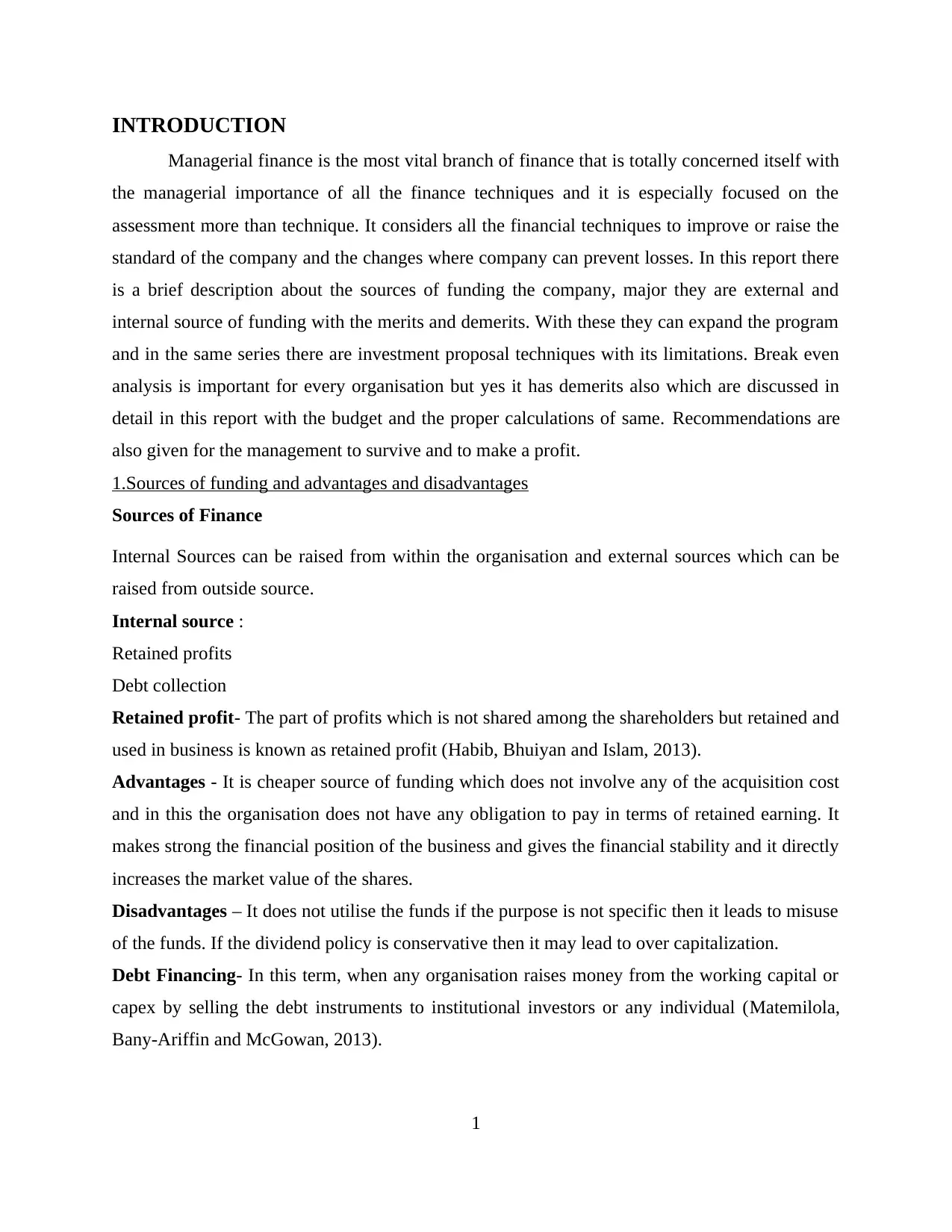
INTRODUCTION
Managerial finance is the most vital branch of finance that is totally concerned itself with
the managerial importance of all the finance techniques and it is especially focused on the
assessment more than technique. It considers all the financial techniques to improve or raise the
standard of the company and the changes where company can prevent losses. In this report there
is a brief description about the sources of funding the company, major they are external and
internal source of funding with the merits and demerits. With these they can expand the program
and in the same series there are investment proposal techniques with its limitations. Break even
analysis is important for every organisation but yes it has demerits also which are discussed in
detail in this report with the budget and the proper calculations of same. Recommendations are
also given for the management to survive and to make a profit.
1.Sources of funding and advantages and disadvantages
Sources of Finance
Internal Sources can be raised from within the organisation and external sources which can be
raised from outside source.
Internal source :
Retained profits
Debt collection
Retained profit- The part of profits which is not shared among the shareholders but retained and
used in business is known as retained profit (Habib, Bhuiyan and Islam, 2013).
Advantages - It is cheaper source of funding which does not involve any of the acquisition cost
and in this the organisation does not have any obligation to pay in terms of retained earning. It
makes strong the financial position of the business and gives the financial stability and it directly
increases the market value of the shares.
Disadvantages – It does not utilise the funds if the purpose is not specific then it leads to misuse
of the funds. If the dividend policy is conservative then it may lead to over capitalization.
Debt Financing- In this term, when any organisation raises money from the working capital or
capex by selling the debt instruments to institutional investors or any individual (Matemilola,
Bany-Ariffin and McGowan, 2013).
1
Managerial finance is the most vital branch of finance that is totally concerned itself with
the managerial importance of all the finance techniques and it is especially focused on the
assessment more than technique. It considers all the financial techniques to improve or raise the
standard of the company and the changes where company can prevent losses. In this report there
is a brief description about the sources of funding the company, major they are external and
internal source of funding with the merits and demerits. With these they can expand the program
and in the same series there are investment proposal techniques with its limitations. Break even
analysis is important for every organisation but yes it has demerits also which are discussed in
detail in this report with the budget and the proper calculations of same. Recommendations are
also given for the management to survive and to make a profit.
1.Sources of funding and advantages and disadvantages
Sources of Finance
Internal Sources can be raised from within the organisation and external sources which can be
raised from outside source.
Internal source :
Retained profits
Debt collection
Retained profit- The part of profits which is not shared among the shareholders but retained and
used in business is known as retained profit (Habib, Bhuiyan and Islam, 2013).
Advantages - It is cheaper source of funding which does not involve any of the acquisition cost
and in this the organisation does not have any obligation to pay in terms of retained earning. It
makes strong the financial position of the business and gives the financial stability and it directly
increases the market value of the shares.
Disadvantages – It does not utilise the funds if the purpose is not specific then it leads to misuse
of the funds. If the dividend policy is conservative then it may lead to over capitalization.
Debt Financing- In this term, when any organisation raises money from the working capital or
capex by selling the debt instruments to institutional investors or any individual (Matemilola,
Bany-Ariffin and McGowan, 2013).
1
⊘ This is a preview!⊘
Do you want full access?
Subscribe today to unlock all pages.

Trusted by 1+ million students worldwide
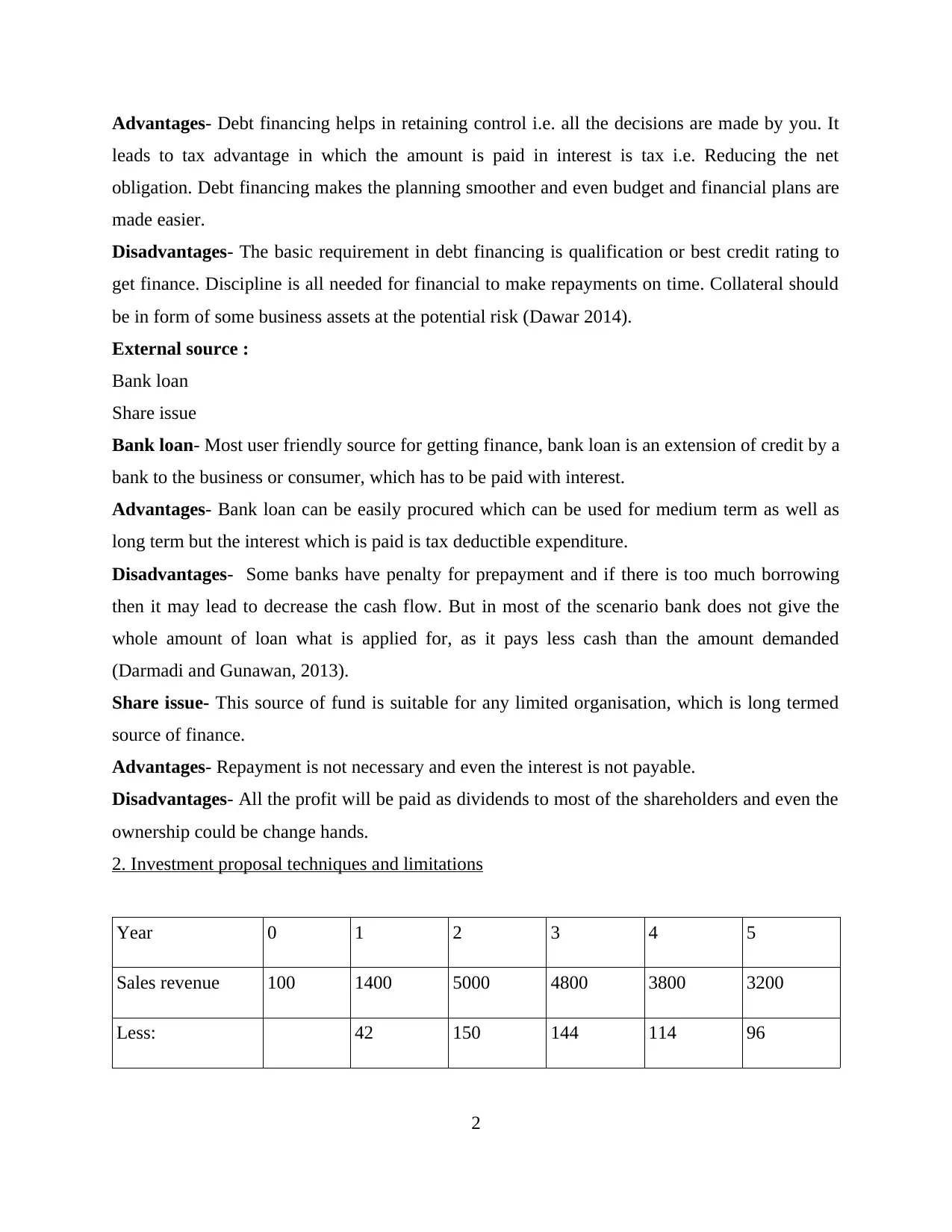
Advantages- Debt financing helps in retaining control i.e. all the decisions are made by you. It
leads to tax advantage in which the amount is paid in interest is tax i.e. Reducing the net
obligation. Debt financing makes the planning smoother and even budget and financial plans are
made easier.
Disadvantages- The basic requirement in debt financing is qualification or best credit rating to
get finance. Discipline is all needed for financial to make repayments on time. Collateral should
be in form of some business assets at the potential risk (Dawar 2014).
External source :
Bank loan
Share issue
Bank loan- Most user friendly source for getting finance, bank loan is an extension of credit by a
bank to the business or consumer, which has to be paid with interest.
Advantages- Bank loan can be easily procured which can be used for medium term as well as
long term but the interest which is paid is tax deductible expenditure.
Disadvantages- Some banks have penalty for prepayment and if there is too much borrowing
then it may lead to decrease the cash flow. But in most of the scenario bank does not give the
whole amount of loan what is applied for, as it pays less cash than the amount demanded
(Darmadi and Gunawan, 2013).
Share issue- This source of fund is suitable for any limited organisation, which is long termed
source of finance.
Advantages- Repayment is not necessary and even the interest is not payable.
Disadvantages- All the profit will be paid as dividends to most of the shareholders and even the
ownership could be change hands.
2. Investment proposal techniques and limitations
Year 0 1 2 3 4 5
Sales revenue 100 1400 5000 4800 3800 3200
Less: 42 150 144 114 96
2
leads to tax advantage in which the amount is paid in interest is tax i.e. Reducing the net
obligation. Debt financing makes the planning smoother and even budget and financial plans are
made easier.
Disadvantages- The basic requirement in debt financing is qualification or best credit rating to
get finance. Discipline is all needed for financial to make repayments on time. Collateral should
be in form of some business assets at the potential risk (Dawar 2014).
External source :
Bank loan
Share issue
Bank loan- Most user friendly source for getting finance, bank loan is an extension of credit by a
bank to the business or consumer, which has to be paid with interest.
Advantages- Bank loan can be easily procured which can be used for medium term as well as
long term but the interest which is paid is tax deductible expenditure.
Disadvantages- Some banks have penalty for prepayment and if there is too much borrowing
then it may lead to decrease the cash flow. But in most of the scenario bank does not give the
whole amount of loan what is applied for, as it pays less cash than the amount demanded
(Darmadi and Gunawan, 2013).
Share issue- This source of fund is suitable for any limited organisation, which is long termed
source of finance.
Advantages- Repayment is not necessary and even the interest is not payable.
Disadvantages- All the profit will be paid as dividends to most of the shareholders and even the
ownership could be change hands.
2. Investment proposal techniques and limitations
Year 0 1 2 3 4 5
Sales revenue 100 1400 5000 4800 3800 3200
Less: 42 150 144 114 96
2
Paraphrase This Document
Need a fresh take? Get an instant paraphrase of this document with our AI Paraphraser
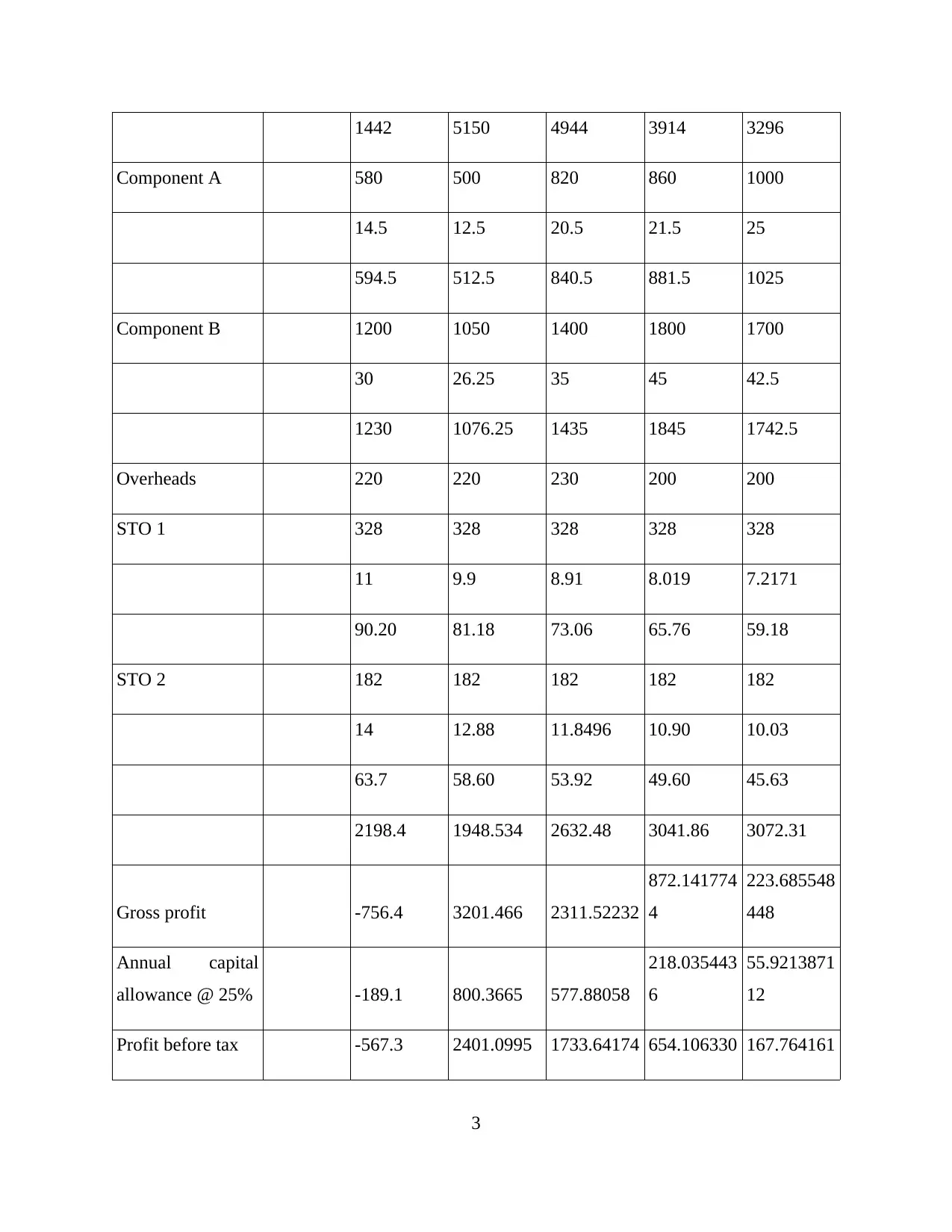
1442 5150 4944 3914 3296
Component A 580 500 820 860 1000
14.5 12.5 20.5 21.5 25
594.5 512.5 840.5 881.5 1025
Component B 1200 1050 1400 1800 1700
30 26.25 35 45 42.5
1230 1076.25 1435 1845 1742.5
Overheads 220 220 230 200 200
STO 1 328 328 328 328 328
11 9.9 8.91 8.019 7.2171
90.20 81.18 73.06 65.76 59.18
STO 2 182 182 182 182 182
14 12.88 11.8496 10.90 10.03
63.7 58.60 53.92 49.60 45.63
2198.4 1948.534 2632.48 3041.86 3072.31
Gross profit -756.4 3201.466 2311.52232
872.141774
4
223.685548
448
Annual capital
allowance @ 25% -189.1 800.3665 577.88058
218.035443
6
55.9213871
12
Profit before tax -567.3 2401.0995 1733.64174 654.106330 167.764161
3
Component A 580 500 820 860 1000
14.5 12.5 20.5 21.5 25
594.5 512.5 840.5 881.5 1025
Component B 1200 1050 1400 1800 1700
30 26.25 35 45 42.5
1230 1076.25 1435 1845 1742.5
Overheads 220 220 230 200 200
STO 1 328 328 328 328 328
11 9.9 8.91 8.019 7.2171
90.20 81.18 73.06 65.76 59.18
STO 2 182 182 182 182 182
14 12.88 11.8496 10.90 10.03
63.7 58.60 53.92 49.60 45.63
2198.4 1948.534 2632.48 3041.86 3072.31
Gross profit -756.4 3201.466 2311.52232
872.141774
4
223.685548
448
Annual capital
allowance @ 25% -189.1 800.3665 577.88058
218.035443
6
55.9213871
12
Profit before tax -567.3 2401.0995 1733.64174 654.106330 167.764161
3
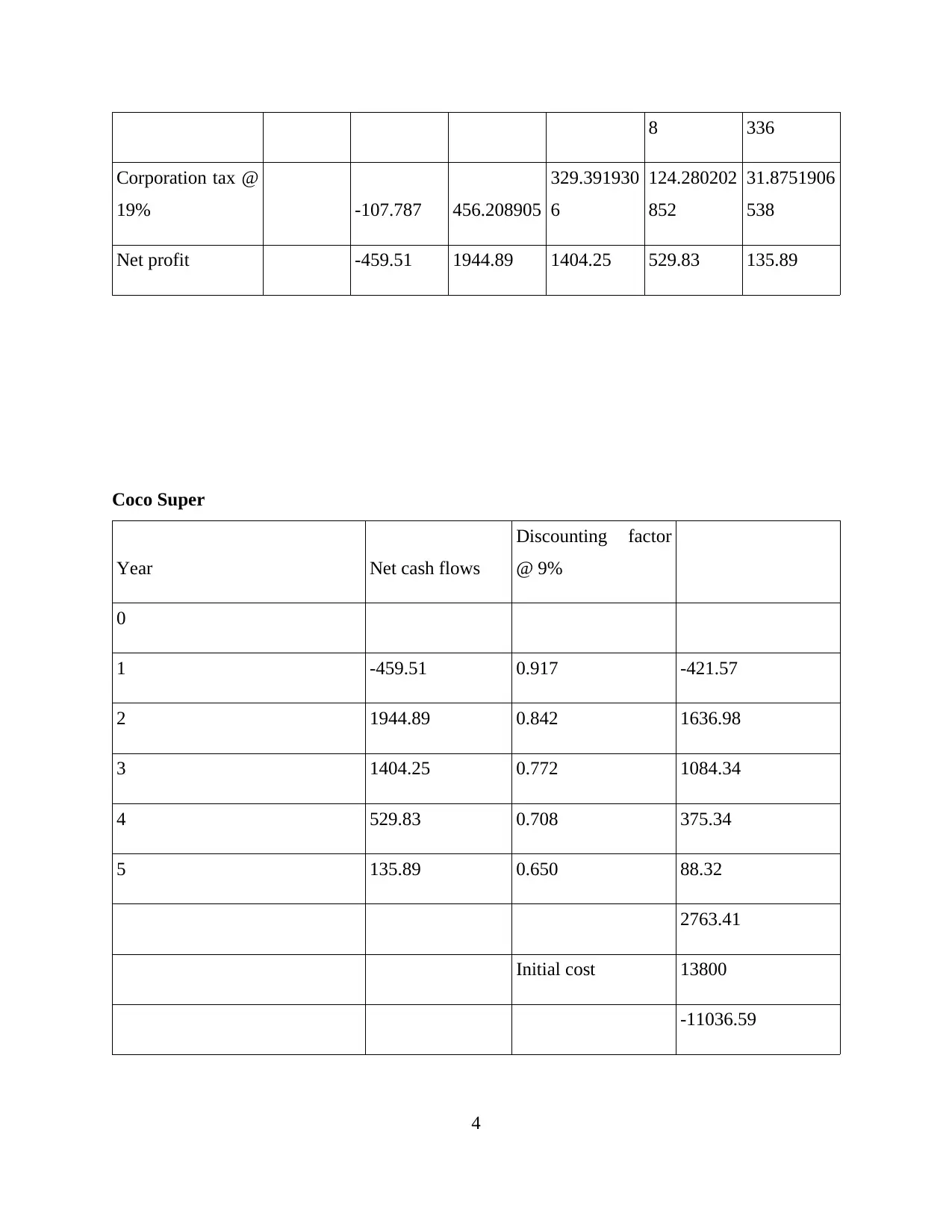
8 336
Corporation tax @
19% -107.787 456.208905
329.391930
6
124.280202
852
31.8751906
538
Net profit -459.51 1944.89 1404.25 529.83 135.89
Coco Super
Year Net cash flows
Discounting factor
@ 9%
0
1 -459.51 0.917 -421.57
2 1944.89 0.842 1636.98
3 1404.25 0.772 1084.34
4 529.83 0.708 375.34
5 135.89 0.650 88.32
2763.41
Initial cost 13800
-11036.59
4
Corporation tax @
19% -107.787 456.208905
329.391930
6
124.280202
852
31.8751906
538
Net profit -459.51 1944.89 1404.25 529.83 135.89
Coco Super
Year Net cash flows
Discounting factor
@ 9%
0
1 -459.51 0.917 -421.57
2 1944.89 0.842 1636.98
3 1404.25 0.772 1084.34
4 529.83 0.708 375.34
5 135.89 0.650 88.32
2763.41
Initial cost 13800
-11036.59
4
⊘ This is a preview!⊘
Do you want full access?
Subscribe today to unlock all pages.

Trusted by 1+ million students worldwide
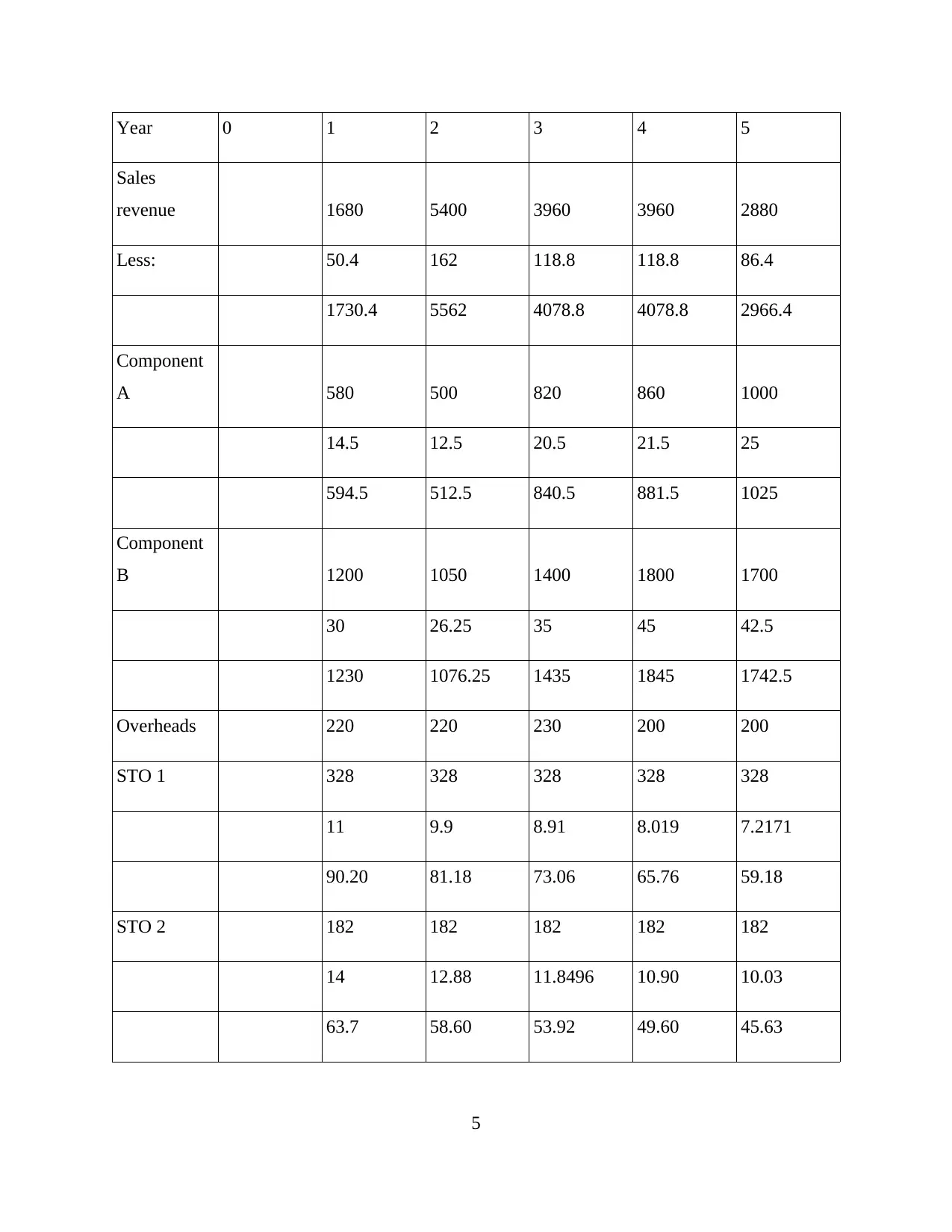
Year 0 1 2 3 4 5
Sales
revenue 1680 5400 3960 3960 2880
Less: 50.4 162 118.8 118.8 86.4
1730.4 5562 4078.8 4078.8 2966.4
Component
A 580 500 820 860 1000
14.5 12.5 20.5 21.5 25
594.5 512.5 840.5 881.5 1025
Component
B 1200 1050 1400 1800 1700
30 26.25 35 45 42.5
1230 1076.25 1435 1845 1742.5
Overheads 220 220 230 200 200
STO 1 328 328 328 328 328
11 9.9 8.91 8.019 7.2171
90.20 81.18 73.06 65.76 59.18
STO 2 182 182 182 182 182
14 12.88 11.8496 10.90 10.03
63.7 58.60 53.92 49.60 45.63
5
Sales
revenue 1680 5400 3960 3960 2880
Less: 50.4 162 118.8 118.8 86.4
1730.4 5562 4078.8 4078.8 2966.4
Component
A 580 500 820 860 1000
14.5 12.5 20.5 21.5 25
594.5 512.5 840.5 881.5 1025
Component
B 1200 1050 1400 1800 1700
30 26.25 35 45 42.5
1230 1076.25 1435 1845 1742.5
Overheads 220 220 230 200 200
STO 1 328 328 328 328 328
11 9.9 8.91 8.019 7.2171
90.20 81.18 73.06 65.76 59.18
STO 2 182 182 182 182 182
14 12.88 11.8496 10.90 10.03
63.7 58.60 53.92 49.60 45.63
5
Paraphrase This Document
Need a fresh take? Get an instant paraphrase of this document with our AI Paraphraser
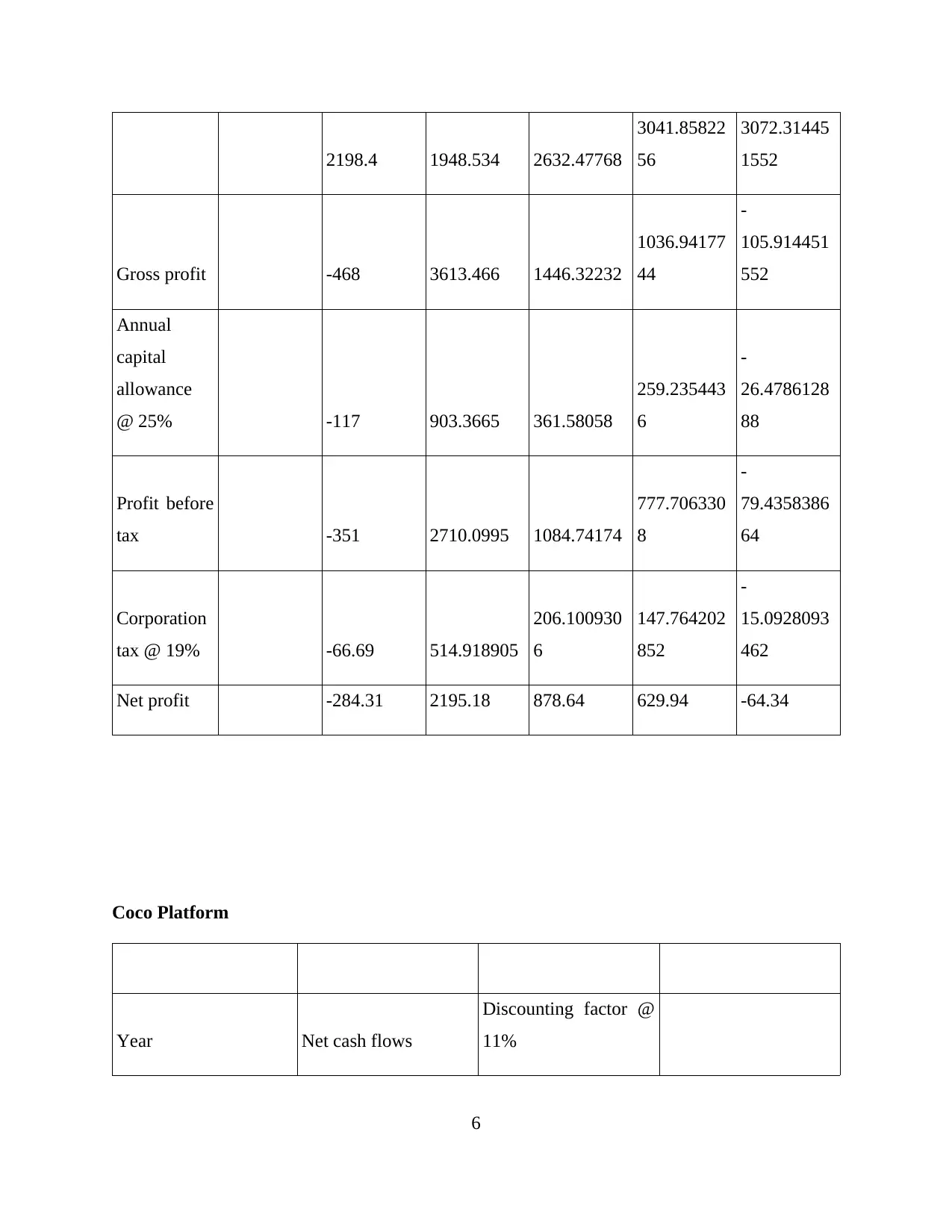
2198.4 1948.534 2632.47768
3041.85822
56
3072.31445
1552
Gross profit -468 3613.466 1446.32232
1036.94177
44
-
105.914451
552
Annual
capital
allowance
@ 25% -117 903.3665 361.58058
259.235443
6
-
26.4786128
88
Profit before
tax -351 2710.0995 1084.74174
777.706330
8
-
79.4358386
64
Corporation
tax @ 19% -66.69 514.918905
206.100930
6
147.764202
852
-
15.0928093
462
Net profit -284.31 2195.18 878.64 629.94 -64.34
Coco Platform
Year Net cash flows
Discounting factor @
11%
6
3041.85822
56
3072.31445
1552
Gross profit -468 3613.466 1446.32232
1036.94177
44
-
105.914451
552
Annual
capital
allowance
@ 25% -117 903.3665 361.58058
259.235443
6
-
26.4786128
88
Profit before
tax -351 2710.0995 1084.74174
777.706330
8
-
79.4358386
64
Corporation
tax @ 19% -66.69 514.918905
206.100930
6
147.764202
852
-
15.0928093
462
Net profit -284.31 2195.18 878.64 629.94 -64.34
Coco Platform
Year Net cash flows
Discounting factor @
11%
6
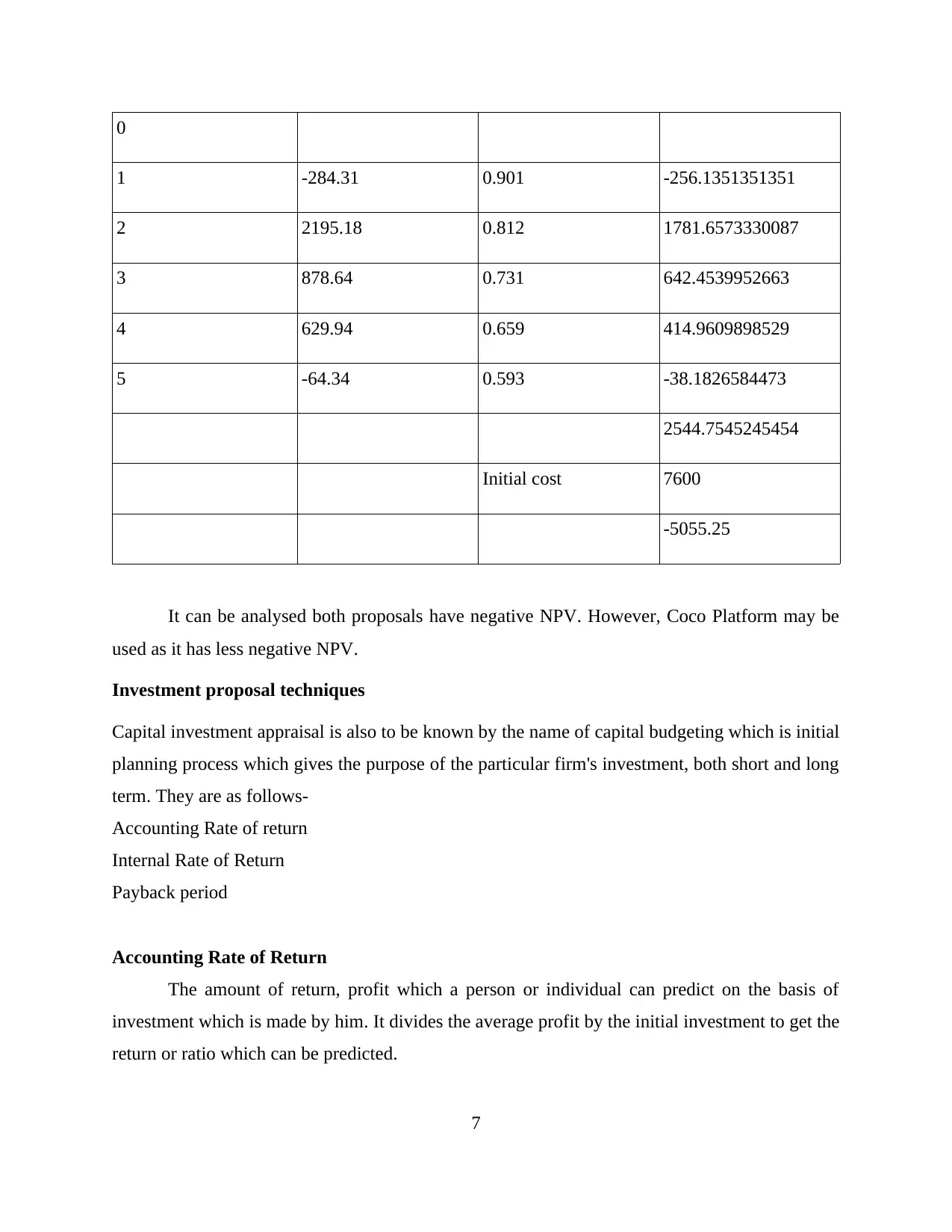
0
1 -284.31 0.901 -256.1351351351
2 2195.18 0.812 1781.6573330087
3 878.64 0.731 642.4539952663
4 629.94 0.659 414.9609898529
5 -64.34 0.593 -38.1826584473
2544.7545245454
Initial cost 7600
-5055.25
It can be analysed both proposals have negative NPV. However, Coco Platform may be
used as it has less negative NPV.
Investment proposal techniques
Capital investment appraisal is also to be known by the name of capital budgeting which is initial
planning process which gives the purpose of the particular firm's investment, both short and long
term. They are as follows-
Accounting Rate of return
Internal Rate of Return
Payback period
Accounting Rate of Return
The amount of return, profit which a person or individual can predict on the basis of
investment which is made by him. It divides the average profit by the initial investment to get the
return or ratio which can be predicted.
7
1 -284.31 0.901 -256.1351351351
2 2195.18 0.812 1781.6573330087
3 878.64 0.731 642.4539952663
4 629.94 0.659 414.9609898529
5 -64.34 0.593 -38.1826584473
2544.7545245454
Initial cost 7600
-5055.25
It can be analysed both proposals have negative NPV. However, Coco Platform may be
used as it has less negative NPV.
Investment proposal techniques
Capital investment appraisal is also to be known by the name of capital budgeting which is initial
planning process which gives the purpose of the particular firm's investment, both short and long
term. They are as follows-
Accounting Rate of return
Internal Rate of Return
Payback period
Accounting Rate of Return
The amount of return, profit which a person or individual can predict on the basis of
investment which is made by him. It divides the average profit by the initial investment to get the
return or ratio which can be predicted.
7
⊘ This is a preview!⊘
Do you want full access?
Subscribe today to unlock all pages.

Trusted by 1+ million students worldwide
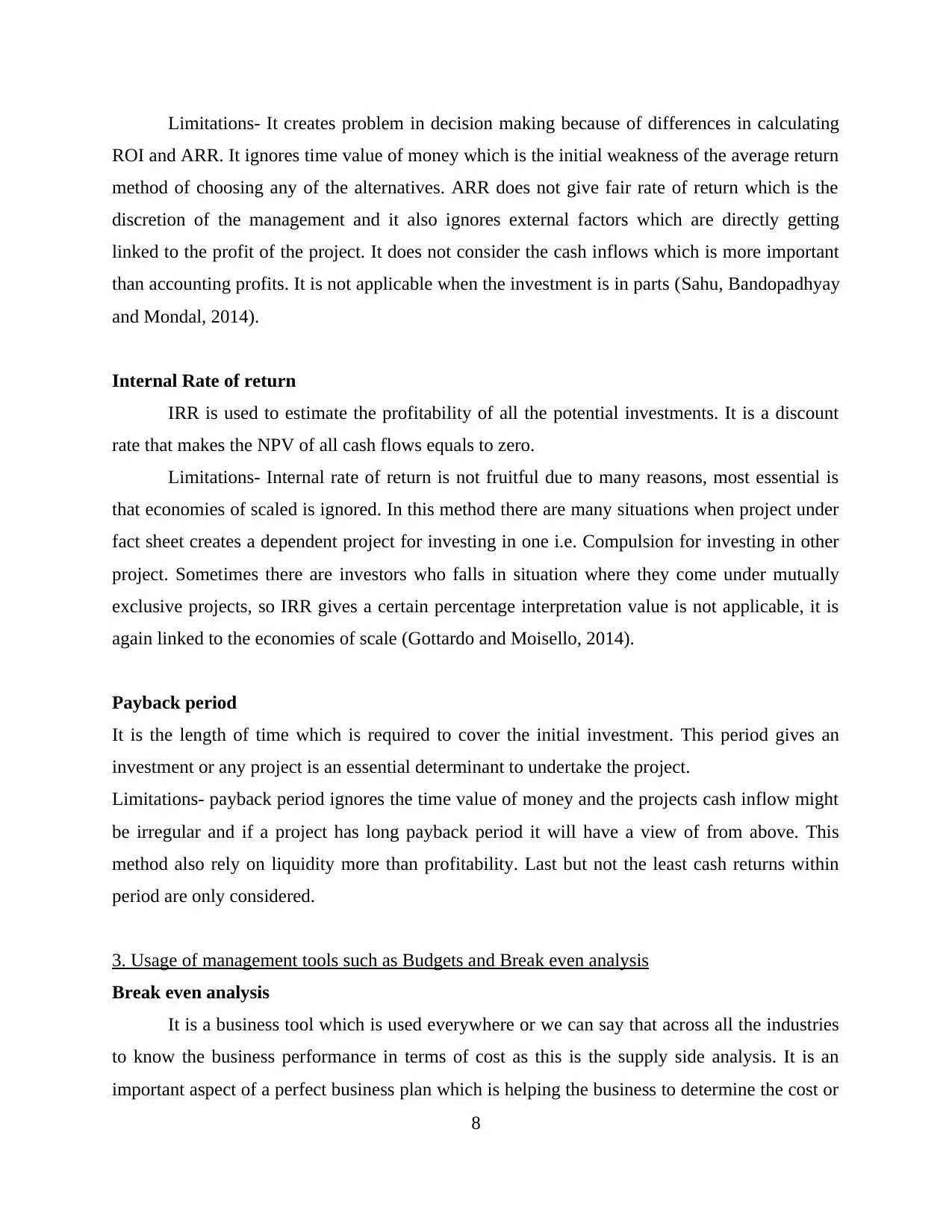
Limitations- It creates problem in decision making because of differences in calculating
ROI and ARR. It ignores time value of money which is the initial weakness of the average return
method of choosing any of the alternatives. ARR does not give fair rate of return which is the
discretion of the management and it also ignores external factors which are directly getting
linked to the profit of the project. It does not consider the cash inflows which is more important
than accounting profits. It is not applicable when the investment is in parts (Sahu, Bandopadhyay
and Mondal, 2014).
Internal Rate of return
IRR is used to estimate the profitability of all the potential investments. It is a discount
rate that makes the NPV of all cash flows equals to zero.
Limitations- Internal rate of return is not fruitful due to many reasons, most essential is
that economies of scaled is ignored. In this method there are many situations when project under
fact sheet creates a dependent project for investing in one i.e. Compulsion for investing in other
project. Sometimes there are investors who falls in situation where they come under mutually
exclusive projects, so IRR gives a certain percentage interpretation value is not applicable, it is
again linked to the economies of scale (Gottardo and Moisello, 2014).
Payback period
It is the length of time which is required to cover the initial investment. This period gives an
investment or any project is an essential determinant to undertake the project.
Limitations- payback period ignores the time value of money and the projects cash inflow might
be irregular and if a project has long payback period it will have a view of from above. This
method also rely on liquidity more than profitability. Last but not the least cash returns within
period are only considered.
3. Usage of management tools such as Budgets and Break even analysis
Break even analysis
It is a business tool which is used everywhere or we can say that across all the industries
to know the business performance in terms of cost as this is the supply side analysis. It is an
important aspect of a perfect business plan which is helping the business to determine the cost or
8
ROI and ARR. It ignores time value of money which is the initial weakness of the average return
method of choosing any of the alternatives. ARR does not give fair rate of return which is the
discretion of the management and it also ignores external factors which are directly getting
linked to the profit of the project. It does not consider the cash inflows which is more important
than accounting profits. It is not applicable when the investment is in parts (Sahu, Bandopadhyay
and Mondal, 2014).
Internal Rate of return
IRR is used to estimate the profitability of all the potential investments. It is a discount
rate that makes the NPV of all cash flows equals to zero.
Limitations- Internal rate of return is not fruitful due to many reasons, most essential is
that economies of scaled is ignored. In this method there are many situations when project under
fact sheet creates a dependent project for investing in one i.e. Compulsion for investing in other
project. Sometimes there are investors who falls in situation where they come under mutually
exclusive projects, so IRR gives a certain percentage interpretation value is not applicable, it is
again linked to the economies of scale (Gottardo and Moisello, 2014).
Payback period
It is the length of time which is required to cover the initial investment. This period gives an
investment or any project is an essential determinant to undertake the project.
Limitations- payback period ignores the time value of money and the projects cash inflow might
be irregular and if a project has long payback period it will have a view of from above. This
method also rely on liquidity more than profitability. Last but not the least cash returns within
period are only considered.
3. Usage of management tools such as Budgets and Break even analysis
Break even analysis
It is a business tool which is used everywhere or we can say that across all the industries
to know the business performance in terms of cost as this is the supply side analysis. It is an
important aspect of a perfect business plan which is helping the business to determine the cost or
8
Paraphrase This Document
Need a fresh take? Get an instant paraphrase of this document with our AI Paraphraser
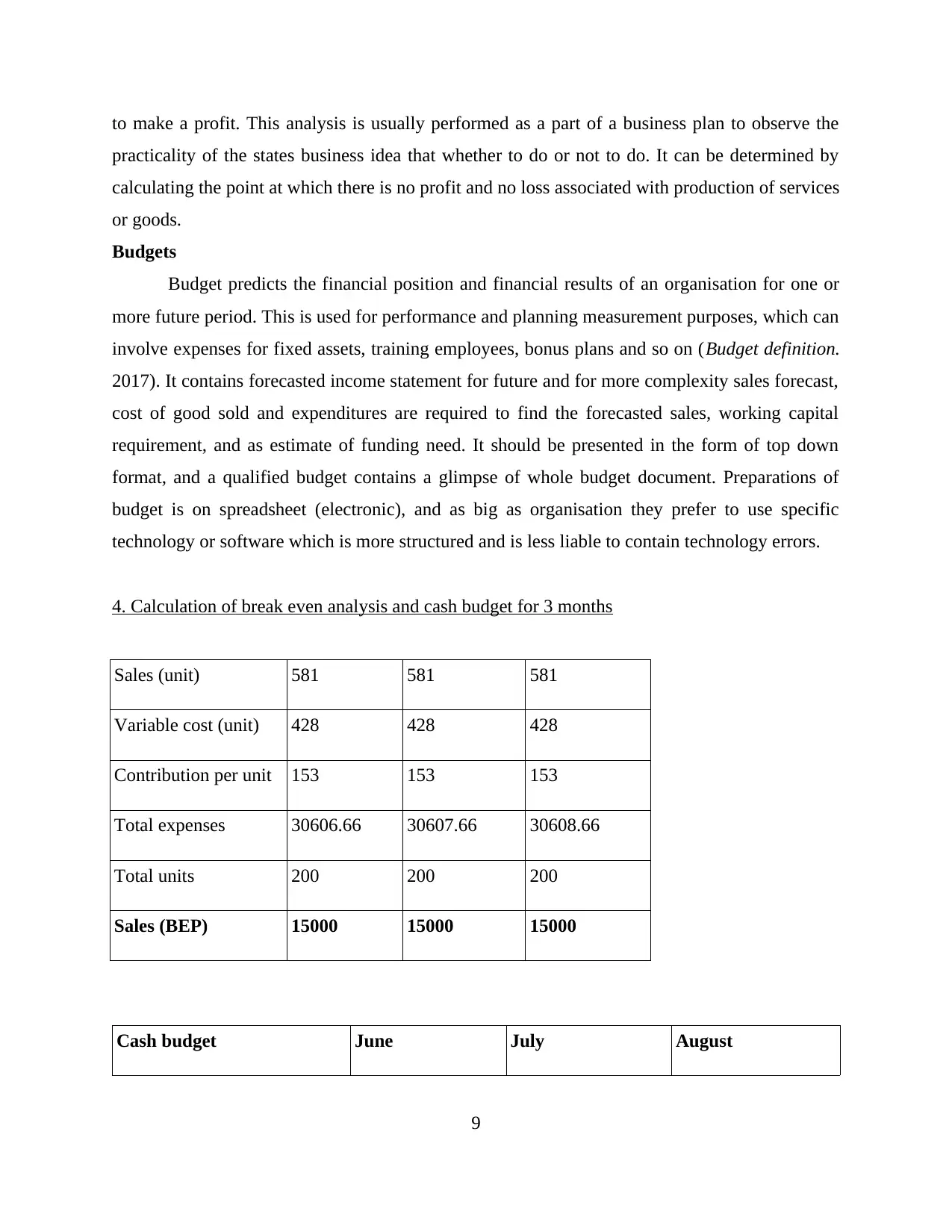
to make a profit. This analysis is usually performed as a part of a business plan to observe the
practicality of the states business idea that whether to do or not to do. It can be determined by
calculating the point at which there is no profit and no loss associated with production of services
or goods.
Budgets
Budget predicts the financial position and financial results of an organisation for one or
more future period. This is used for performance and planning measurement purposes, which can
involve expenses for fixed assets, training employees, bonus plans and so on (Budget definition.
2017). It contains forecasted income statement for future and for more complexity sales forecast,
cost of good sold and expenditures are required to find the forecasted sales, working capital
requirement, and as estimate of funding need. It should be presented in the form of top down
format, and a qualified budget contains a glimpse of whole budget document. Preparations of
budget is on spreadsheet (electronic), and as big as organisation they prefer to use specific
technology or software which is more structured and is less liable to contain technology errors.
4. Calculation of break even analysis and cash budget for 3 months
Sales (unit) 581 581 581
Variable cost (unit) 428 428 428
Contribution per unit 153 153 153
Total expenses 30606.66 30607.66 30608.66
Total units 200 200 200
Sales (BEP) 15000 15000 15000
Cash budget June July August
9
practicality of the states business idea that whether to do or not to do. It can be determined by
calculating the point at which there is no profit and no loss associated with production of services
or goods.
Budgets
Budget predicts the financial position and financial results of an organisation for one or
more future period. This is used for performance and planning measurement purposes, which can
involve expenses for fixed assets, training employees, bonus plans and so on (Budget definition.
2017). It contains forecasted income statement for future and for more complexity sales forecast,
cost of good sold and expenditures are required to find the forecasted sales, working capital
requirement, and as estimate of funding need. It should be presented in the form of top down
format, and a qualified budget contains a glimpse of whole budget document. Preparations of
budget is on spreadsheet (electronic), and as big as organisation they prefer to use specific
technology or software which is more structured and is less liable to contain technology errors.
4. Calculation of break even analysis and cash budget for 3 months
Sales (unit) 581 581 581
Variable cost (unit) 428 428 428
Contribution per unit 153 153 153
Total expenses 30606.66 30607.66 30608.66
Total units 200 200 200
Sales (BEP) 15000 15000 15000
Cash budget June July August
9
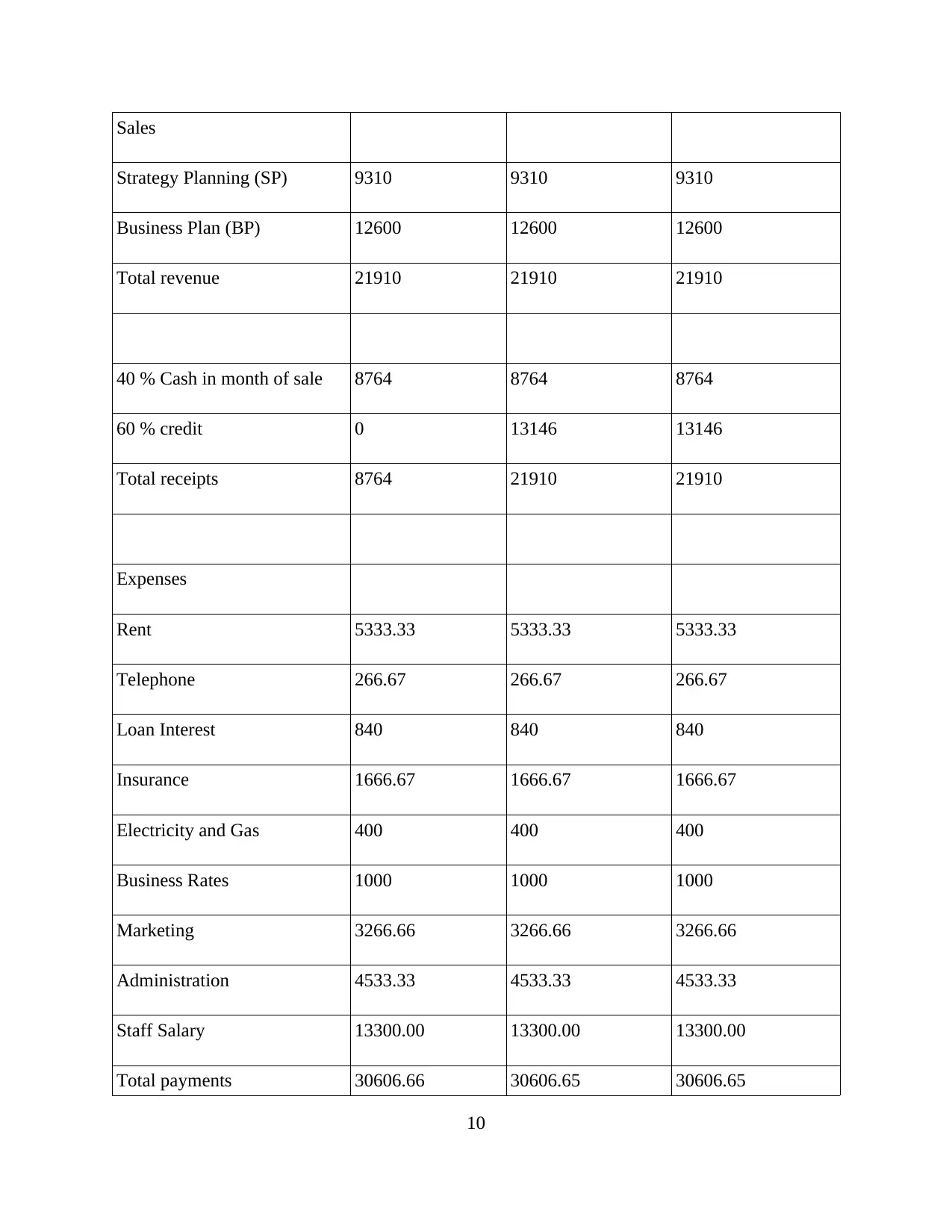
Sales
Strategy Planning (SP) 9310 9310 9310
Business Plan (BP) 12600 12600 12600
Total revenue 21910 21910 21910
40 % Cash in month of sale 8764 8764 8764
60 % credit 0 13146 13146
Total receipts 8764 21910 21910
Expenses
Rent 5333.33 5333.33 5333.33
Telephone 266.67 266.67 266.67
Loan Interest 840 840 840
Insurance 1666.67 1666.67 1666.67
Electricity and Gas 400 400 400
Business Rates 1000 1000 1000
Marketing 3266.66 3266.66 3266.66
Administration 4533.33 4533.33 4533.33
Staff Salary 13300.00 13300.00 13300.00
Total payments 30606.66 30606.65 30606.65
10
Strategy Planning (SP) 9310 9310 9310
Business Plan (BP) 12600 12600 12600
Total revenue 21910 21910 21910
40 % Cash in month of sale 8764 8764 8764
60 % credit 0 13146 13146
Total receipts 8764 21910 21910
Expenses
Rent 5333.33 5333.33 5333.33
Telephone 266.67 266.67 266.67
Loan Interest 840 840 840
Insurance 1666.67 1666.67 1666.67
Electricity and Gas 400 400 400
Business Rates 1000 1000 1000
Marketing 3266.66 3266.66 3266.66
Administration 4533.33 4533.33 4533.33
Staff Salary 13300.00 13300.00 13300.00
Total payments 30606.66 30606.65 30606.65
10
⊘ This is a preview!⊘
Do you want full access?
Subscribe today to unlock all pages.

Trusted by 1+ million students worldwide
1 out of 16
Related Documents
Your All-in-One AI-Powered Toolkit for Academic Success.
+13062052269
info@desklib.com
Available 24*7 on WhatsApp / Email
![[object Object]](/_next/static/media/star-bottom.7253800d.svg)
Unlock your academic potential
Copyright © 2020–2025 A2Z Services. All Rights Reserved. Developed and managed by ZUCOL.





